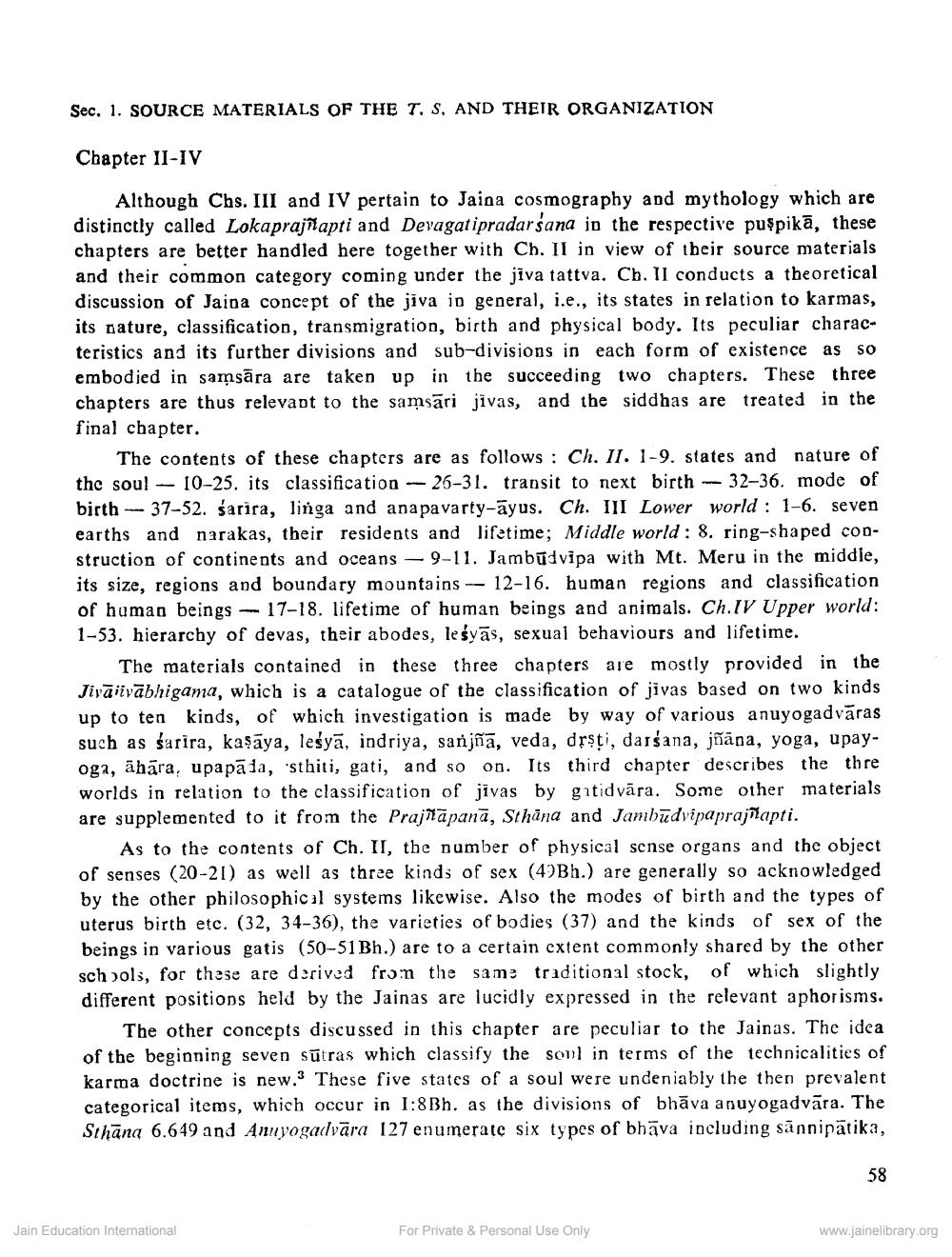________________
Sec, 1. SOURCE MATERIALS OF THE T. S, AND THEIR ORGANIZATION
Chapter II-IV
Although Chs. III and IV pertain to Jaina cosmography and mythology which are distinctly called Lokaprajñapti and Devagatipradarśana in the respective puspikā, these chapters are better handled here together with Ch. Il in view of their source materials and their common category coming under the jiva tattva. Ch. Il conducts a theoretical discussion of Jaina concept of the jiva in general, i.e., its states in relation to karmas, its nature, classification, transmigration, birth and physical body. Its peculiar characteristics and its further divisions and sub-divisions in each form of existence as so embodied in samsāra are taken up in the succeeding two chapters. These three chapters are thus relevant to the samsāri jivas, and the siddhas are treated in the final chapter.
The contents of these chapters are as follows: Ch. II. 1-9. states and nature of the soul - 10-25. its classification - 25-31. transit to next birth - 32–36. mode of birth -- 37-52. sarira, linga and anapavarty-āyus. Ch. II Lower world : 1-6. seven earths and narakas, their residents and lifetime; Middle world : 8. ring-shaped construction of continents and oceans - 9-11. Jambūdvipa with Mt. Meru in the middle, its size, regions and boundary mountains - 12-16. human regions and classification of human beings - 17-18. lifetime of human beings and animals. Ch.IV Upper world: 1-53. hierarchy of devas, their abodes, leśyās, sexual behaviours and lifetime.
The materials contained in these three chapters are mostly provided in the Jivājivābhigama, which is a catalogue of the classification of jivas based on two kinds up to ten kinds, of which investigation is made by way of various anuyogadvāras such as sarira, kasāya, leśyā, indriya, sanjña, veda, drști, darśana, jñāna, yoga, upayoga, āhāra, upapāia, sthiti, gati, and so on. Its third chapter describes the thre worlds in relation to the classification of jivas by gitidvāra. Some other materials are supplemented to it from the Prajñāpanā, Sthāna and Jambūdvipaprajñapti.
As to the contents of Ch. II, the number of physical sense organs and the object of senses (20-21) as well as three kinds of sex (40Bh.) are generally so acknowledged by the other philosophical systems likewise. Also the modes of birth and the types of uterus birth etc. (32, 34-36), the varieties of bodies (37) and the kinds of sex of the beings in various gatis (50-51 Bh.) are to a certain cxtent commonly shared by the other schols, for these are derived from the same traditional stock, of which slightly different positions held by the Jainas are lucidly expressed in the relevant aphorisms.
The other concepts discussed in this chapter are peculiar to the Jainas. The idea of the beginning seven sūtras which classify the soul in terms of the technicalities of karma doctrine is new. These five states of a soul were undeniably the then prevalent categorical items, which occur in 1:8 Bh. as the divisions of bhāva anuyogadvāra. The Sthāna 6.649 and Annyogadvāra 127 enumerate six types of bhāva including sännipātika,
58
Jain Education International
For Private & Personal Use Only
www.jainelibrary.org




